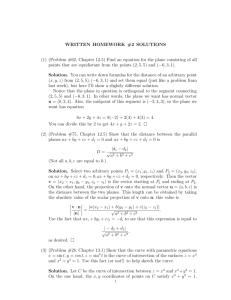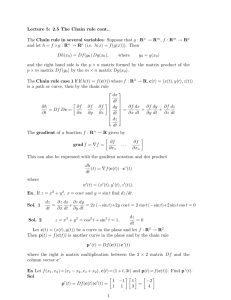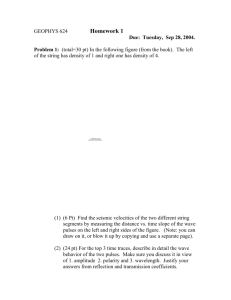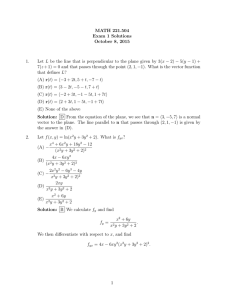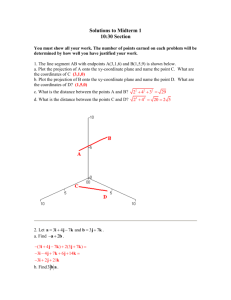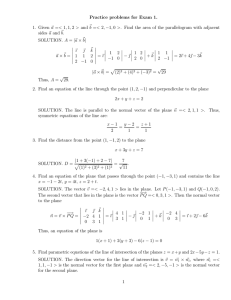–2 –101 2 x –2–10 1 y 0 1 2 3 4 z
advertisement
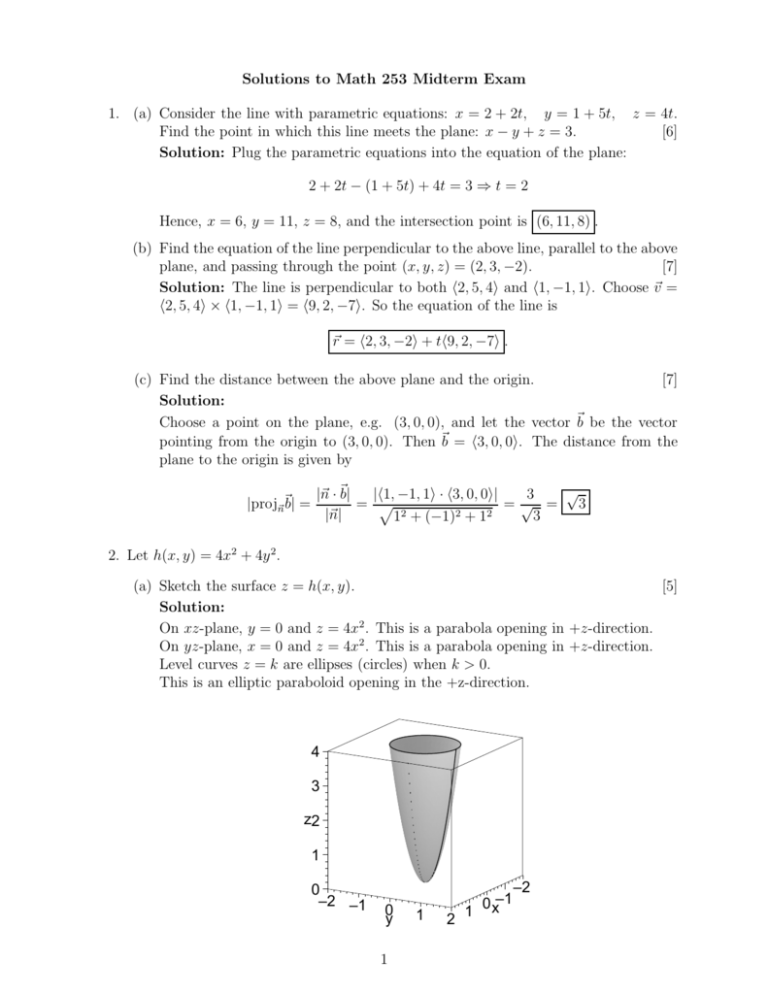
Solutions to Math 253 Midterm Exam 1. (a) Consider the line with parametric equations: x = 2 + 2t, y = 1 + 5t, z = 4t. Find the point in which this line meets the plane: x − y + z = 3. [6] Solution: Plug the parametric equations into the equation of the plane: 2 + 2t − (1 + 5t) + 4t = 3 ⇒ t = 2 Hence, x = 6, y = 11, z = 8, and the intersection point is (6, 11, 8) . (b) Find the equation of the line perpendicular to the above line, parallel to the above plane, and passing through the point (x, y, z) = (2, 3, −2). [7] Solution: The line is perpendicular to both h2, 5, 4i and h1, −1, 1i. Choose ~v = h2, 5, 4i × h1, −1, 1i = h9, 2, −7i. So the equation of the line is ~r = h2, 3, −2i + th9, 2, −7i . (c) Find the distance between the above plane and the origin. [7] Solution: Choose a point on the plane, e.g. (3, 0, 0), and let the vector ~b be the vector pointing from the origin to (3, 0, 0). Then ~b = h3, 0, 0i. The distance from the plane to the origin is given by √ |h1, −1, 1i · h3, 0, 0i| 3 |~n · ~b| |proj~n~b| = = p =√ = 3 |~n| 3 12 + (−1)2 + 12 2. Let h(x, y) = 4x2 + 4y 2. (a) Sketch the surface z = h(x, y). [5] Solution: On xz-plane, y = 0 and z = 4x2 . This is a parabola opening in +z-direction. On yz-plane, x = 0 and z = 4x2 . This is a parabola opening in +z-direction. Level curves z = k are ellipses (circles) when k > 0. This is an elliptic paraboloid opening in the +z-direction. 4 3 z2 1 0 –2 –1 0 y 1 1 2 0 –1 1 x –2 (b) Write the equation for this surface in cylindrical coordinates z = z(r, θ). Solution: Since x2 + y 2 = r 2 , the equation z = 4x2 + 4y 2 becomes z = 4r 2 . [5] (c) Write the equation for this surface in spherical coordinates ρ = ρ(θ, φ) [5] Solution: Since x = ρ sin φ cos θ, y = ρ sin φ sin θ, and z = ρ cos φ, The equation becomes ρ cos φ = 4ρ2 sin2 φ cos2 θ + 4ρ2 sin2 φ sin2 θ = 4ρ2 sin2 φ Then the spherical representation is given by ρ = cos φ 4 sin2 φ . (d) Find the equation of the plane tangent to the surface z = h(x, y) at the point (x, y, z) = (1, 1, 8). [5] Solution: hx (x, y) = 8x, hy (x, y) = 8y. So the equation of the tangent plane is z = 8 + hx (1, 1)(x − 1) + hy (1, 1)(y − 1), or z = 8 + 8(x − 1) + 8(y − 1) . 3. Find and classify the critical points of f (x, y) = x3 − y 3 − 2xy + 6. [20] Solution: This was a homework problem! Refer to the solutions to assignment 5, problem 2. The critical points are the solutions to fx = 3x2 − 2y = 0 and fy = −3y 2 − 2x = 0. The first equation gives y = 32 x2 , and substituting into the second gives −3( 32 x2 )2 − 2x = 0, which simplifies to x(27x3 + 8) = 0, and so the critical points are (0, 0) and (−2/3, 2/3). Now, to apply the second derivative test, we have fxx = 6x fyy = −6y fxy = −2 D = −36xy − 4 At (0, 0), D = −4 so it is a saddle. At (−2/3, 2/3), D = 12 > 0 and fxx = −4 < 0, so it is a maximum. Summarizing: local max at (−2/3, 2/3), saddle at (0, 0) 4. (a) Calculate the gradient of the function g(x, y) = xexy . [6] Solution: ∇g = hexy + xyexy , x2 exy i (b) At the point (1, 0), in what direction will g decrease most rapidly? [7] Solution: ∇g(1, 0) = h1, 1i. The direction of most rapid decrease is −∇g(1, 0) = h−1, −1i . (c) What is the directional derivative in that direction? [7] √ √ Solution: The unit vector in that direction is h−1/ 2, −1/ 2i. The directional √ √ derivative is D~u g(1, 0) = ~u · ∇g(1, 0) = −2/ 2 = − 2 5. Find the maximum and minimum values of the function F (x, y) = xy on the ellipse defined by x2 + 4y 2 = 4, and the points at which the max and min occur. [20] Solution: Using the Lagrange multiplier method to find the extremes of F (x, y), subject to the constraint g(x, y) = x2 + 4y 2 = 4. we need to solve the vector equation 2 ∇F = λ∇g together with the constraint equation. The vector equation gives the two scalar equations: y = 2λx, x = 8λy which, implies (eliminating λ) that y/2x = x/4y and therefore x2 = 4y 2√ . Putting this 2 2 into the constraint equation, we conclude that x + x = 4 and so x = ± 2. It follows √ that y = ± 2/2, with independent ± signs. Calculating the values of F at the four candidate points, we find that √ √ √ √ F (x, y) has a maximum value +1 at ( 2, 2/2) and (− 2, − 2/2) √ √ √ √ F (x, y) has a minimum value -1 at (− 2, 2/2) and ( 2, − 2/2) 3
